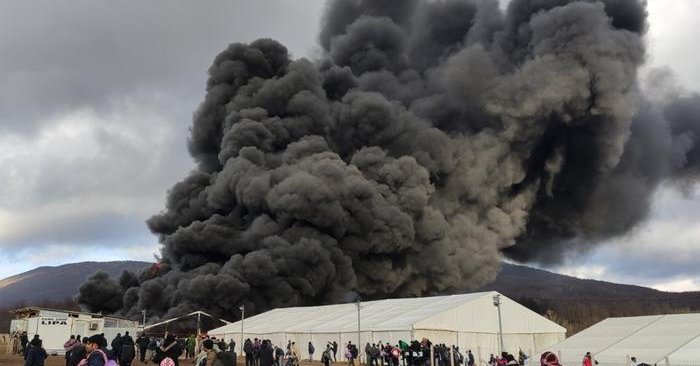A day after the International Organization for Migration (IOM), which had been providing humanitarian support to the Lipa migrant camp, declared the facility closed due to the Bosnian government’s lack of support, it was destroyed by a fire likely started by the camp’s former residents.
The images of billowing black smoke and homeless migrants in dire need of humanitarian aid amid rural Bosnia’s wintery landscape received international media attention, highlighting Bosnia’s failure to provide adequate accommodation for the migrants and asylum seekers — people on the move — on its territory.
The European Union (EU) has seized the opportunity to criticize BiH’s failure to develop a comprehensive and sustainable solution for migrants and asylum seekers in the country. In remarks made on January 19, 2021, EU Home Affairs Commissioner Ylva Johansson declared that “Bosnia-Herzegovina must show it’s capable of managing migration” and “address the humanitarian situation.”
Certainly, BiH can and must do better. Many of Lipa’s former inhabitants were left stranded in stationary busses for up to 36 hours after the fire, as any progress towards a more stable resolution was restrained by local populations’ resistance and the country’s deep institutional paralysis. But for the EU to not reflect on its own role in seeding the ground of this crisis is misguided.
People on the move are relatively new to BiH; whereas a mere 750 were registered in the country in 2017, UNHCR, the UN’s Refugee Organization, recorded 68,000 arrivals from 2018 to 2020. This dramatic rise stems from the hardening borders of EU members, mainly Hungary and Croatia. These developments made transit through BiH the only viable route for people on the move traveling north through the Balkans.
Una-Sana Canton, in Northwest BiH, has hosted the largest number of asylum seekers, but this is not due to any particular fondness between them and local authorities. In 2018, Šuhret Fazlić, the mayor of Bihać, Una-Sana’s administrative center, told the New York Times that “I don’t want them here, and they don’t want to be here either.” Why then, if neither the asylum seekers nor local Bosnian officials want them there, have they stayed?
People on the move in BiH, who mainly are from Afghanistan, Pakistan, Bangladesh, and Morocco, seek to cross the border into Croatia, an EU member, and then travel onwards to Slovenia or Italy, both of which are part of the Schengen Area. This journey has become increasingly dangerous, particularly as the COVID-19 pandemic has provided an impetus for Croatian border forces to force would-be border crossers back into Bosnia with increasingly dehumanizing tactics.
Personal accounts from asylum seekers whose repeated attempts to reach Croatia had failed highlight a disturbing trend of abuse and theft by Croatian authorities. Moreover, a systematic pushback chain running from Italy to Slovenia to Croatia to BiH has developed, as people on the move who spend weeks traveling by foot to Trieste, Italy are returned back to BiH in a matter of days.
These pushbacks are illegal under EU law and are prohibited by the European Convention on Human Rights, yet they have continued to take place. The European Commission’s new Pact on Migration, released in September 2020, legally guarantees “individual assessment of asylum claims” and increased monitoring of member border forces, but these oversight measures are likely insufficient. Indeed, in November 2020, the EU ombudsman launched an inquiry into the European Commission’s role in withholding details about the Croatian government’s failure to spend EU money allotted to border force supervision.
Commissioner Johansson’s remarks that BiH “must show it’s capable of managing migration,” then, could just as easily be made about the EU itself, particularly as the humanitarian crisis in Bosnia exists as a function of EU policy.
“Managing migration” is easier said than done, of course, as EU member states and institutions like the European Commission must balance a range of other issues: domestic sentiment chief among them. But the bloc’s response to the situation in BiH cannot be to criticize BiH’s failures without acknowledging that the actions of EU states themselves are necessary prologues to any analysis of what BiH could do differently. Particularly in the era of “No more Morias,” a failure to wrestle with this reality is deeply discordant with the New Pact on Migration’s call for “Effective Solidarity.”
Bosnia-Herzegovina may be the single worst-equipped country in Europe to grapple with a significant number of people on the move. Its majority Serb entity, Republika Srpska, rejects any notion of housing asylum seekers, and the over 88 million euros that the EU has provided BiH with have not produced a sustainable solution.
Roughly 8,000 of the 2.2 million Bosnians displaced by the 1992-95 war remain scattered across 158 collective centers for the displaced, a full quarter century after the Dayton Accords ended the war. The debate in late 2019 about the future of Vučjak camp, built outside Bihać on an old dump surrounded by minefields, foreshadowed the current discussions, as local prejudices, competing sovereignties, and deep tensions between BiH’s ethnic groups inhibited any meaningful progress towards a long-term solution.
Knowing this, it defies reality for the EU to expect that BiH could become a safe holding pen for undesired migrants and asylum seekers, no matter how much funding the EU supplies the IOM’s Bosnian operation with. The EU now faces a choice: does it continue to maintain the artificial distinction between people on the move’s status in BiH and EU policies? Or will the bloc and its members take a new, human-focused approach, taking on some political risk in the effort to create a more sustainable and humane solution?
The answer is uncertain. What is clear, however, is that if the EU wants to avoid further humanitarian crises on its doorstep, it must take a new approach and no longer treat BiH as a holding ground for people it does not want to deal with.

Follow the comments: |
|
